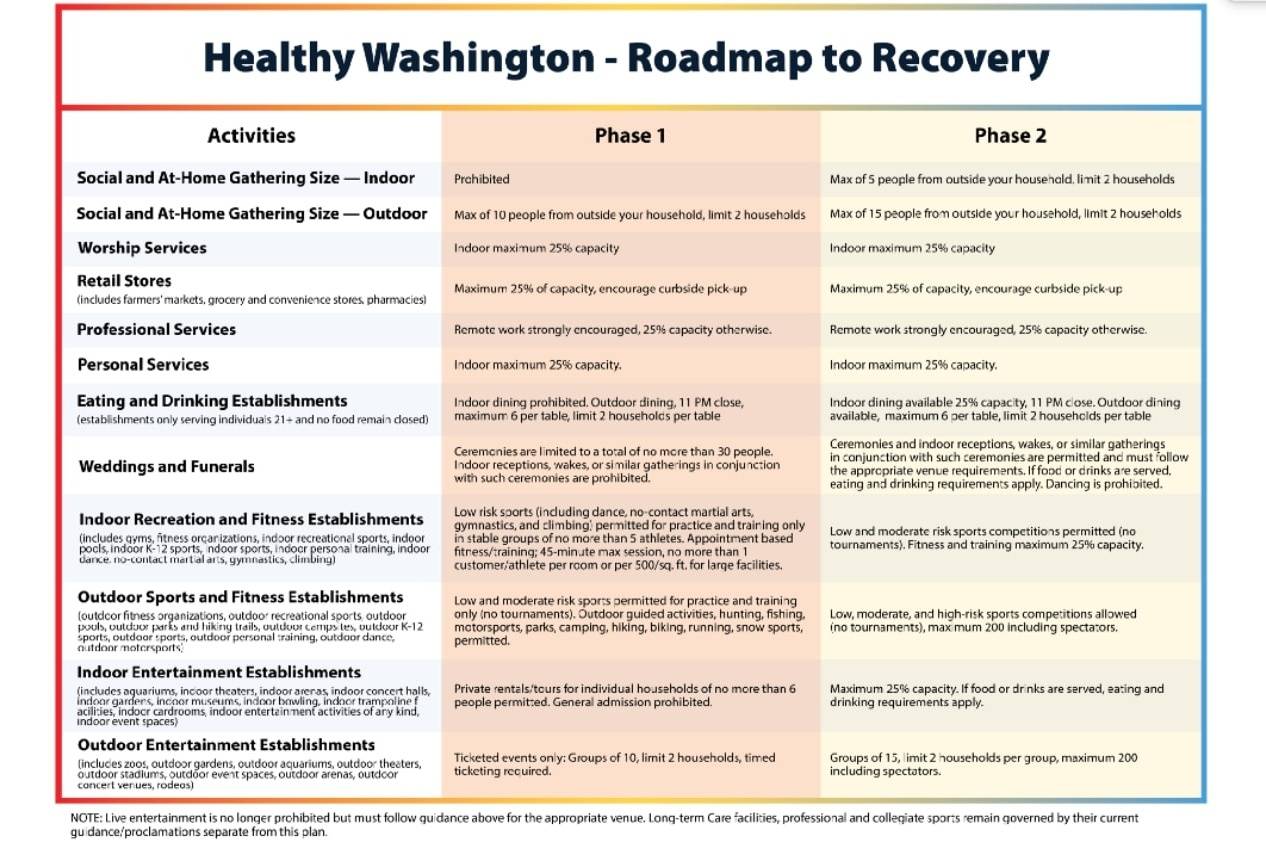Staff reports
Gov. Jay Inslee on Tuesday announced “Healthy Washington — Roadmap to Recovery,” a COVID-19 phased recovery plan. Beginning on Jan. 11, the state will follow a regional recovery approach with every region beginning in Phase 1.
The governor’s office reports “this new recovery system aims to safely ease some restrictions while also maintaining crucial hospital capacity, ensuring care for Washingtonians that need it and paving the way for economic recovery.”
Below is a summary of the phases, regions and metrics in the recovery plan.
Phase 1
• All regions will begin in Phase 1 because of current metrics.
• Phase 1 mostly aligns with restrictions currently in place for most counties today, with a few key exceptions. Indoor fitness and outdoor entertainment, for example, were both previously prohibited, but will now be permitted with restrictions.
• Currently, all indoor fitness is entirely prohibited. The Department of Health (DOH) now believes that the state can safely allow appointment-based fitness and training where there is no more than one customer per room or 500 square feet for large facilities. This will allow gyms to schedule people wanting to come in to work out in a safe way to ensure activity during winter months. Masks and physical distancing are required.
• Outdoor entertainment establishments will be permitted to reopen in Phase 1, including zoos, outdoor theaters and concert venues, and rodeos, among other outdoor venues. Operation must be by ticketed event only with groups of 10 maximum with a limit of two households. Timed ticketing is required, as well as facial coverings and physical distancing.
• Indoor gatherings and indoor dining remain prohibited. Outdoor dining with a maximum of six and limit for two households per table is permitted with an 11 p.m. close.
• Retail, worship services, personal services and professional services — where remote work isn’t available — are limited to 25% capacity.
Phase 2
• Once a region meets all four required health metrics for three of the four past weeks, they will be permitted to move from Phase 1 to Phase 2. This phase sees some relaxation in regulations, but masks and physical distancing are still required statewide for all activities.
• Indoor social gatherings with people outside of the household will be permitted in Phase 2 with a maximum of five people from outside the household and limit of two households. Outdoor social gatherings maximum in this phase is increased to 15 individuals from two households.
• In Phase 2, indoor dining will be permitted with a maximum 25% capacity and an 11 p.m. close. All other indoor activities must also follow a 25% capacity limit. This includes retail, entertainment and groceries as well as personal and professional services.
• Indoor fitness facilities must also follow the 25% capacity limit.
• In Phase 2, moderate risk indoor sports and all sports outdoors gain flexibility to have league games and competitions, which will help ensure opportunities for kids to be active, which is especially important during winter months and as kids navigate virtual or hybrid schooling.
• Outdoor entertaining may host groups of up to 15 with the two-household limit and an overall 75-person maximum. Wedding and funeral ceremonies and indoor receptions may take place following the appropriate venue requirements. Food and drink service limited to restaurant guidance.
Regions
The eight regions in Washington mostly based on Emergency Medical Services (EMS) regions used for evaluating healthcare services. There will be eight regions of four or more counties, divided according to available health care services based on metrics such as hospitalizations, case data and disease mobility. The regions are as follows:
• Central: King, Pierce, Snohomish counties
• East: Adams, Asotin, Ferry, Garfield, Lincoln, Pend Oreille, Spokane, Stevens, Whitman counties
• North: Island, San Juan, Skagit, Whatcom counties
• North Central: Chelan, Douglas, Grant, Okanogan counties
• Northwest: Clallam, Jefferson, Kitsap, Mason counties
• South Central: Benton, Columbia, Franklin, Kittitas, Walla Walla, Yakima counties
• Southwest: Clark, Cowlitz, Klickitat, Skamania, Wahkiakum counties
• West: Grays Harbor, Lewis, Pacific, Thurston counties
Metrics
A region’s phase will be determined by the Department of Health (DOH) in response to four metric requirements. The final metrics for regions will be calculated on Jan. 8 and will be effective Jan. 11.
To go forward from Phase 1 to Phase 2, regions must meet all four metrics:
• Decreasing trend in two-week rate of COVID-19 cases per 100K population (decrease >10%)
• Decreasing trend in two-week rate new COVID-19 hospital admission rates per 100K population (decrease >10%)
• ICU occupancy (total — COVID-19 and non-COVID-19) of less than 90%
• COVID-19 test positivity rate of <10%
To remain in Phase 2, regions must meet at least 3 metrics:
• Decreasing or flat trend in two-week rate of COVID-19 cases per 100K population
• Decreasing or flat trend in two-week rate new COVID-19 hospital admission rates per 100K population
• ICU occupancy (total — COVID-19 and non-COVID-19) of less than 90%
• COVID-19 test positivity rate of <10%.
Regions that fail to meet two or more of the above metrics will be moved back to Phase 1.
The metrics for each region will be updated on the state’s Risk Assessment Dashboard every Friday. Dependent on a region’s metrics, DOH will move into a new phase — forward or backward — the following Monday.
Talk to us
Please share your story tips by emailing editor@kentreporter.com.
To share your opinion for publication, submit a letter through our website https://www.kentreporter.com/submit-letter/. Include your name, address and daytime phone number. (We’ll only publish your name and hometown.) Please keep letters to 300 words or less.

